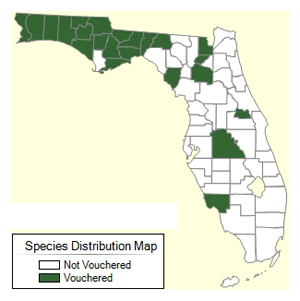Plant Profile: Canada Goldenrod
By Sarah Bailey
This
post is one of a series from professor Nisse Goldberg's Plant Taxonomy
students at Jacksonville University.
Classification
Kingdom: Plantae
Phylum: Magnoliophyta
Class: Magnoliopsida
Order: Asterales
Family: Asteraceae
Genus: Solidago
Specific Epithet: canadensis
Variety: scabra
Botanical Name: Solidago canadensis var. scabra
Common Name: Canada Goldenrod
Habitat
Although Solidago canadensis var. scabra (Canada goldenrod) is found primarily in the northwestern portions of Florida, it grows in the state's interior as well (Fig. 2). You can find this plant in meadows, waterways, ditches along roads, and large fields that are not tended to or grazed by animals. Its growing season extends from July to October.
Characteristics
Canada goldenrod belongs to the Asteraceae (sunflower) family and can easily be identified by its panicles of bright yellow flowers (Fig. 3). Individual flowers are relatively small and found at the tips of the stems. Leaves are alternately arranged along the plant's stems and are bigger at the base of the plant. The leaves are covered with tiny hairs, have jagged edges, and are 5-12.5 cm long. The stems can range from 20-214 cm in height. S. canadensis is rhizomatous - it has underground stems that produce roots and upward-growing shoots. Goldenrod fruit is an achene, which is a dry fruit that does not open to release its seed. Native bees, honeybees, and butterflies play a large role in pollinating the flowers, especially in the late summer and fall. It also attracts pollen-eating beetles!
Growth Habit
Solidago canadensis var. scabra is somewhat difficult to control - its rhizomes enable it to form large beds. In some areas it is considered a weed and is currently on the Invasive Species List in Europe and East Asia. To prevent unwanted spreading, consider growing it in a pot, so it does not outcompete other plants for space in a garden. It is also useful to remove the flower heads before the seeds ripen to prevent spreading.
Applications
There are many uses for Canada goldenrod. It is used to re-vegetate disturbed habitats because it is fast-growing and able to spread easily. It is also useful as food for cattle, sheep, and horses! The plant has even been used as a natural dye for wool. It has many medicinal properties. In fact, the name Solidago means "to make whole or to heal". Infusions of the flowers and roots have been used to treat fevers, diarrhea, and flu-like symptoms including sore throats and body aches.
References
Coladonato, Milo. 1993. Solidago canadensis. In: Fire Effects Information System, [Online]. U.S.
Department of Agriculture, Forest Service, Rocky Mountain Research Station, Fire Sciences Laboratory
(Producer). Available: http://www.fs.fed.us/database/feis/ [2012, April 3].
Pavek, P.L.S. 2011. Plant guide for Canada goldenrod (Solidago canadensis). USDA-Natural Resources
Conservation Service. Pullman, WA.
Solidago canadensis: Canada Goldenrod (2002). Earl J.S. Rook. Retrieved on April 4, 2012, from
http://www.rook.org/earl/bwca/nature/herbs/solidagocan.html
Image sources
Figure 1. http://florida.plantatlas.usf.edu/Photo.aspx?id=1980
Figure 2. http://florida.plantatlas.usf.edu/TempFiles/MapPic_Species3031.jpeg
Figure 3. http://www.shirleydenton.com/plants/web_pics/s/solidago_can_fl0091.jpg
 |
| Figure 1. Solidago canadensis var. scabra. Photo credit: Shirley Denton. |
Classification
Kingdom: Plantae
Phylum: Magnoliophyta
Class: Magnoliopsida
Order: Asterales
Family: Asteraceae
Genus: Solidago
Specific Epithet: canadensis
Variety: scabra
Botanical Name: Solidago canadensis var. scabra
Common Name: Canada Goldenrod
Habitat
Although Solidago canadensis var. scabra (Canada goldenrod) is found primarily in the northwestern portions of Florida, it grows in the state's interior as well (Fig. 2). You can find this plant in meadows, waterways, ditches along roads, and large fields that are not tended to or grazed by animals. Its growing season extends from July to October.
 |
| Figure 2. Distribution in Florida. |
Canada goldenrod belongs to the Asteraceae (sunflower) family and can easily be identified by its panicles of bright yellow flowers (Fig. 3). Individual flowers are relatively small and found at the tips of the stems. Leaves are alternately arranged along the plant's stems and are bigger at the base of the plant. The leaves are covered with tiny hairs, have jagged edges, and are 5-12.5 cm long. The stems can range from 20-214 cm in height. S. canadensis is rhizomatous - it has underground stems that produce roots and upward-growing shoots. Goldenrod fruit is an achene, which is a dry fruit that does not open to release its seed. Native bees, honeybees, and butterflies play a large role in pollinating the flowers, especially in the late summer and fall. It also attracts pollen-eating beetles!
 |
| Figure 3. Solidago inflorescence. Photo credit: Shirley Denton. |
Solidago canadensis var. scabra is somewhat difficult to control - its rhizomes enable it to form large beds. In some areas it is considered a weed and is currently on the Invasive Species List in Europe and East Asia. To prevent unwanted spreading, consider growing it in a pot, so it does not outcompete other plants for space in a garden. It is also useful to remove the flower heads before the seeds ripen to prevent spreading.
Applications
There are many uses for Canada goldenrod. It is used to re-vegetate disturbed habitats because it is fast-growing and able to spread easily. It is also useful as food for cattle, sheep, and horses! The plant has even been used as a natural dye for wool. It has many medicinal properties. In fact, the name Solidago means "to make whole or to heal". Infusions of the flowers and roots have been used to treat fevers, diarrhea, and flu-like symptoms including sore throats and body aches.
References
Coladonato, Milo. 1993. Solidago canadensis. In: Fire Effects Information System, [Online]. U.S.
Department of Agriculture, Forest Service, Rocky Mountain Research Station, Fire Sciences Laboratory
(Producer). Available: http://www.fs.fed.us/database/feis/ [2012, April 3].
Pavek, P.L.S. 2011. Plant guide for Canada goldenrod (Solidago canadensis). USDA-Natural Resources
Conservation Service. Pullman, WA.
Solidago canadensis: Canada Goldenrod (2002). Earl J.S. Rook. Retrieved on April 4, 2012, from
http://www.rook.org/earl/bwca/nature/herbs/solidagocan.html
Image sources
Figure 1. http://florida.plantatlas.usf.edu/Photo.aspx?id=1980
Figure 2. http://florida.plantatlas.usf.edu/TempFiles/MapPic_Species3031.jpeg
Figure 3. http://www.shirleydenton.com/plants/web_pics/s/solidago_can_fl0091.jpg



Comments